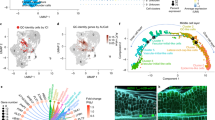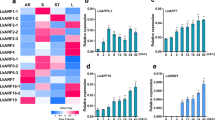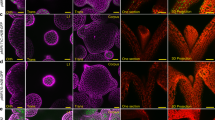Abstract
Induction of pluripotent cells termed callus by auxin represents a typical cell fate change required for plant in vitro regeneration; however, the molecular control of auxin-induced callus formation is largely elusive. We previously identified four Arabidopsis auxin-inducible Lateral Organ Boundaries Domain (LBD) transcription factors that govern callus formation. Here, we report that Arabidopsis basic region/leucine zipper motif 59 (AtbZIP59) transcription factor forms complexes with LBDs to direct auxin-induced callus formation. We show that auxin stabilizes AtbZIP59 and enhances its interaction with LBD, and that disruption of AtbZIP59 dampens auxin-induced callus formation whereas overexpression of AtbZIP59 triggers autonomous callus formation. AtbZIP59–LBD16 directly targets a FAD-binding Berberine (FAD-BD) gene and promotes its transcription, which contributes to callus formation. These findings define the AtbZIP59–LBD complex as a critical regulator of auxin-induced cell fate change during callus formation, which provides a new insight into the molecular regulation of plant regeneration and possible developmental programs.
This is a preview of subscription content, access via your institution
Access options
Access Nature and 54 other Nature Portfolio journals
Get Nature+, our best-value online-access subscription
$29.99 / 30 days
cancel any time
Subscribe to this journal
Receive 12 digital issues and online access to articles
$119.00 per year
only $9.92 per issue
Buy this article
- Purchase on Springer Link
- Instant access to full article PDF
Prices may be subject to local taxes which are calculated during checkout





Similar content being viewed by others
References
Birnbaum, K. D. & Sanchez Alvarado, A. Slicing across kingdoms: regeneration in plants and animals. Cell 132, 697–710 (2008).
Sugimoto, K., Gordon, S. P. & Meyerowitz, E. M. Regeneration in plants and animals: dedifferentiation, transdifferentiation, or just differentiation? Trends Cell. Biol. 21, 212–218 (2011).
Skoog, F. & Miller, C. O. Chemical regulation of growth and organ formation in plant tissues cultured in vitro. Symp. Soc. Exp. Biol. 54, 118–130 (1957).
Valvekens, D., Montagu, M. V. & Van Lijsebettens, M. Agrobacterium tumefaciens-mediated transformation of Arabidopsis thaliana root explants by using kanamycin selection. Proc. Natl Acad. Sci. USA 85, 5536–5540 (1988).
Gordon, S. P. et al. Pattern formation during de novo assembly of the Arabidopsis shoot meristem. Development 134, 3539–3548 (2007).
Chandler, J. W. Founder cell specification. Trends Plant Sci. 16, 607–613 (2011).
Ahmad, P. et al. Role of transgenic plants in agriculture and biopharming. Biotechnol. Adv. 30, 524–540 (2012).
Viacheslavova, A. O. et al. Expression of heterologous genes in plant systems: new possibilities. Genetika 48, 1245–1259 (2012).
Atta, R. et al. Pluripotency of Arabidopsis xylem pericycle underlies shoot regeneration from root and hypocotyl explants grown in vitro. Plant J. 57, 626–644 (2009).
Sugimoto, K., Jiao, Y. & Meyerowitz, E. M. Arabidopsis regeneration from multiple tissues occurs via a root development pathway. Dev. Cell. 18, 463–471 (2010).
Che, P., Lall, S. & Howell, S. H. Developmental steps in acquiring competence for shoot development in Arabidopsis tissue culture. Planta 226, 1183–1194 (2007).
Laplaze, L. et al. GAL4-GFP enhancer trap lines for genetic manipulation of lateral root development in Arabidopsis thaliana. J. Exp. Bot. 56, 2433–2442 (2005).
Okushima, Y., Fukaki, H., Onoda, M., Theologis, A. & Tasaka, M. ARF7 and ARF19 regulate lateral root formation via direct activation of LBD/ASL genes in Arabidopsis. Plant Cell. 19, 118–130 (2007).
Lee, H. W., Kim, N. Y., Lee, D. J. & Kim, J. LBD18/ASL20 regulates lateral root formation in combination with LBD16/ASL18 downstream of ARF7 and ARF19 in Arabidopsis. Plant Physiol. 151, 1377–1389 (2009).
Fan, M., Xu, C., Xu, K. & Hu, Y. LATERAL ORGAN BOUNDARIES DOMAIN transcription factors direct callus formation in Arabidopsis regeneration. Cell. Res. 22, 1169–1180 (2012).
Rosspopoff, O. et al. Direct conversion of root primordium into shoot meristem relies on timing of stem cell niche development. Development 144, 1187–1200 (2017).
Iwase, A. et al. The AP2/ERF transcription factor WIND1 controls cell dedifferentiation in Arabidopsis. Curr. Biol. 21, 508–514 (2011).
Ikeuchi, M. et al. Wounding triggers callus formation via dynamic hormonal and transcriptional changes. Plant Physiol. 175, 1158–1174 (2017).
Jakoby, M. et al. bZIP transcription factors in Arabidopsis. Trends Plant Sci. 7, 106–111 (2002).
Deppmann, C. D. et al. Dimerization specificity of all 67 B-ZIP motifs in Arabidopsis thaliana: a comparison to Homo sapiens B-ZIP motifs. Nucleic Acids Res. 32, 3435–3445 (2004).
Vinson, C. R., Sigler, P. B. & McKnight, S. L. Scissors-grip model for DNA recognition by a family of leucine zipper proteins. Science 246, 911–916 (1989).
Ellenberger, T. E., Brandl, C. J., Struhl, K. & Harrison, S. C. The GCN4 basic region leucine zipper binds DNA as a dimer of uninterrupted alpha helices: crystal structure of the protein-DNA complex. Cell 71, 1223–1237 (1992).
Tsugama, D., Liu, S. & Takano, T. Analysis of functions of VIP1 and its close homologs in osmosensory responses of Arabidopsis thaliana. PLoS ONE 9, e103930 (2014).
Van Oosten, M. J., Sharkhuu, A., Batelli, G., Bressan, R. A. & Maggio, A. The Arabidopsis thalian a mutant air1 implicates SOS3 in the regulation of anthocyanins under salt stress. Plant Mol. Biol. 83, 405–415 (2013).
Walter, M. et al. Visualization of protein interactions in living plant cells using bimolecular fluorescence complementation. Plant J. 40, 428–438 (2004).
Daniel, B. et al. Oxidation of monolignols by members of the berberine bridge enzyme family suggests a role in plant cell wall metabolism. J. Biol. Chem. 290, 18770–18781 (2015).
Lee, H. W., Kim, M. J., Kim, N. Y., Lee, S. H. & Kim, J. LBD18 acts as a transcriptional activator that directly binds to the EXPANSIN14 promoter in promoting lateral root emergence of Arabidopsis. Plant J. 73, 212–224 (2013).
Xu, K. et al. A genome-wide transcriptome profiling reveals the early molecular events during callus initiation in Arabidopsis multiple organs. Genomics 100, 116–124 (2012).
Heyman, J. et al. The heterodimeric transcription factor complex ERF115–PAT1 grants regeneration competence. Nat. Plants 2, 16165 (2016).
Zhong, L. P. et al. Overexpression of insulin-like growth factor binding protein 3 in oral squamous cell carcinoma. Oncol. Rep. 20, 1441–1447 (2008).
Rizzino, A. & Wuebben, E. L. Sox2/Oct4: A delicately balanced partnership in pluripotent stem cells and embryogenesis. Biochim. Biophys. Acta 1859, 780–791 (2016).
Casimiro, I. et al. Dissecting Arabidopsis lateral root development. Trends Plant Sci. 8, 165–171 (2003).
Casimiro, I. et al. Auxin transport promotes Arabidopsis lateral root initiation. Plant Cell. 13, 843–852 (2001).
Aida, M. et al. The PLETHORA genes mediate patterning of the Arabidopsis root stem cell niche. Cell 119, 109–120 (2004).
Haecker, A. et al. Expression dynamics of WOX genes mark cell fate decisions during early embryonic patterning in Arabidopsis thaliana. Development 131, 657–668 (2004).
Hu, Y., Xie, Q. & Chua, N. H. The Arabidopsis auxin-inducible gene ARGOS controls lateral organ size. Plant Cell. 15, 1951–1961 (2003).
Chinnusamy, V. et al. ICE1: a regulator of cold-induced transcriptome and freezing tolerance in Arabidopsis. Genes. Dev. 17, 1043–1054 (2003).
Funakoshi, M. & Hochstrasser, M. Small epitope-linker modules for PCR-based C-terminal tagging in Saccharomyces cerevisiae. Yeast 26, 185–192 (2009).
Robinson, C. R. & Sauer, R. T. Optimizing the stability of single-chain proteins by linker length and composition mutagenesis. Proc. Natl Acad. Sci. USA 95, 5929–5934 (1998).
Clough, S. J. & Bent, A. F. Floral dip: a simplified method for Agrobacterium-mediated transformation of Arabidopsis thaliana. Plant J. 16, 735–743 (1998).
Livak, K. J. & Schmittgen, T. D. Analysis of relative gene expression data using real-time quantitative PCR and the 2(-Delta Delta C(T)) Method. Methods 25, 402–408 (2001).
Bharti, K. et al. Isolation and characterization of HsfA3, a new heat stress transcription factor of Lycopersicon peruvianum. Plant J. 22, 355–365 (2000).
Voinnet, O., Rivas, S., Mestre, P. & Baulcombe, D. An enhanced transient expression system in plants based on suppression of gene silencing by the p19 protein of tomato bushy stunt virus. Plant J. 33, 949–956 (2003).
Kim, J. H. & Kende, H. A transcriptional coactivator, AtGIF1, is involved in regulating leaf growth and morphology in Arabidopsis. Proc. Natl Acad. Sci. USA 101, 13374–13379 (2004).
Bowler, C. et al. Chromatin techniques for plant cells. Plant J. 39, 776–789 (2004).
Zhang, T. Q. et al. A two-step model for de novo activation of WUSCHEL during plant shoot regeneration. Plant Cell. 29, 1073–1087 (2017).
Lin, X. L. et al. An Arabidopsis SUMO E3 ligase, SIZ1, negatively regulates photomorphogenesis by promoting COP1 activity. PLoS Genet. 12, e1006016 (2016).
Gallie, D. R. & Kado, C. I. A translational enhancer derived from tobacco mosaic virus is functionally equivalent to a Shine-Dalgarno sequence. Proc. Natl Acad. Sci. USA 86, 129–132 (1989).
Gallie, D. R., Lucas, W. J. & Walbot, V. Visualizing mRNA expression in plant protoplasts: factors influencing efficient mRNA uptake and translation. Plant Cell. 1, 301–311 (1989).
Yoo, S. D., Cho, Y. H. & Sheen, J. Arabidopsis mesophyll protoplasts: a versatile cell system for transient gene expression analysis. Nat. Protoc. 2, 1565–1572 (2007).
Acknowledgements
We are grateful to B. Scheres, J. Haseloff, N.-H. Chua, J.-W. Wang and J. Jin for providing the seeds and constructs used in this study. We thank J. M. Alonso (North Carolina State University) for critical comments on the manuscript. We acknowledge K. Yang for help in preparing some of the constructs for the co-IP experiment. This work was supported by the National Natural Science Foundation of China (grant no. 31230009 and grant no. 31771632), the Ministry of Science and Technology of China (grant no. 2013CB967300) and the Strategic Priority Research Program of Chinese Academy of Sciences (grant no. XDPB0403).
Author information
Authors and Affiliations
Contributions
Y.H. conceived the project; C.X. and Y.H. designed the experiments; C.X., H.C., H.W. and W.X. performed the experiments; Q.Z., E.X., S.Z., R.Y. and D.Y. contributed to the generation of some constructs; C.X. and Y.H. analysed the data and wrote the manuscript.
Corresponding author
Ethics declarations
Competing interests
The authors declare no competing financial interests.
Additional information
Publisher’s note: Springer Nature remains neutral with regard to jurisdictional claims in published maps and institutional affiliations.
Supplementary information
Supplementary Information
Supplementary Figures 1–6, Supplementary Table 1
Rights and permissions
About this article
Cite this article
Xu, C., Cao, H., Zhang, Q. et al. Control of auxin-induced callus formation by bZIP59–LBD complex in Arabidopsis regeneration. Nature Plants 4, 108–115 (2018). https://doi.org/10.1038/s41477-017-0095-4
Received:
Accepted:
Published:
Issue Date:
DOI: https://doi.org/10.1038/s41477-017-0095-4
This article is cited by
-
Transcriptome analysis reveals the effect of propyl gallate on kiwifruit callus formation
Plant Cell Reports (2024)
-
Glucosinolate O-methyltransferase mediated callus formation and affected ROS homeostasis in Arabidopsis thaliana
Physiology and Molecular Biology of Plants (2024)
-
Regulatory roles of noncoding RNAs in callus induction and plant cell dedifferentiation
Plant Cell Reports (2023)
-
Picloram enhanced the callus induction, growth kinetics, antioxidant potentials, and secondary metabolites production of Zingiber officinale var. rubrum callus cultures
Plant Cell, Tissue and Organ Culture (PCTOC) (2023)
-
GWAS across multiple environments and WGCNA suggest the involvement of ZmARF23 in embryonic callus induction from immature maize embryos
Theoretical and Applied Genetics (2023)



